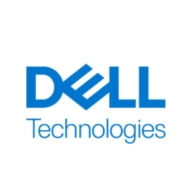


Dell PowerMax and Hitachi Virtual Storage Platform compete in the high-end enterprise storage category. Dell PowerMax seems to have the upper hand in advanced data reduction capabilities and performance metrics.
Features: Dell PowerMax includes robust data reduction capabilities, high availability features like SRDF replication, and integration with NVMe storage. It excels in speed and performance, offering impressive latency and IOPS figures. Hitachi Virtual Storage Platform offers features like Global Active Device for enhanced data management, comprehensive virtualization, and scalability benefits.
Room for Improvement: Hitachi Virtual Storage Platform could improve its user interface and simplify complex setups to enhance user experience. Additionally, reducing costs and integrating modern technologies offer opportunities for growth. Dell PowerMax requires better GUI interfaces and AI features, while improvements in cost-efficiency could address pricing concerns.
Ease of Deployment and Customer Service: Hitachi Virtual Storage Platform deployment is viewed as complex, with varying ease across different environments, along with suggested improvements in technical support responsiveness. Dell PowerMax shows deployment complexity yet benefits from knowledgeable customer support, though it still has room for service enhancements.
Pricing and ROI: Both solutions are considered expensive but come with features that justify the cost due to stability and performance. Hitachi offers competitive pricing, with potential improvements in cost models. Dell PowerMax is perceived as costly, although significant discounts are available. Both provide high ROI due to reliability and performance benefits.
If you wait more than seven years to buy another one, you get a return on your investment.
During a DCDR setup and migration from VMAX to Dell PowerMax, what was planned as a two-day downtime was completed in just three to four hours.
The performance metrics or benchmarks I use to measure success with Dell PowerMax include uptime as well as our response times on our platforms, both of which are exactly where we want them to be, which is five nines and as fast as possible.
My client has seen significant ROI since the install, and when you don't go down, that's an ROI in and of itself.
While performance, security, and financial aspects of Hitachi Virtual Storage Platform are satisfactory, I am unsure about the exact return on investment.
Customers always have their issues resolved promptly.
Technical support is good at least through vendors, not directly with the principal.
I would rate Dell PowerMax support as a ten, as I have never had an issue with Dell support as it relates to this product.
ProSupport Next Business Day offers part replacement within four hours for data leaks.
Dell support for Dell PowerMax is exceptional, rating a perfect 10 out of 10.
The time taken to act upon issues is quite large, and issue identification takes a significant amount of time, especially when it comes to critical problems.
It hasn't broken down anytime in the last six to seven years, despite hurricanes, earthquakes, and power outages.
Scalability is not an issue.
Dell PowerMax is good for enterprises, and it also depends on how much workload you're going to bring in on Dell PowerMax in terms of performance and how many users are going to use the database you're hosting.
PowerScale is better suited for AI and overall buzz solution currently.
I would rate the stability of the product at seven out of ten.
These patches can be applied on the fly without requiring software upgrades or system downtime.
I would rate it nine out of ten since there are no required downtimes, even during firmware upgrades.
There has been no downtime with Dell PowerMax; it's been extremely reliable, easy to manage, easy to upgrade, and trustworthy as we've upgraded over the years from one version to another.
If we are running on a standalone infrastructure, I would rate Hitachi Virtual Storage Platform a 10 for stability.
One way to improve the product is to add an operational assistant that doesn't depend on VMware.
I would like to see some AI features that would allow arrays to intelligently identify threats or unusual behavior in the data pattern and give an alert.
Storage replication should be essential.
Compared to competitors such as NetApp, which integrates with public cloud hyperscalers (GCP, Azure, AWS), Dell PowerMax lacks in this aspect.
Dell can assist by providing plug-and-play integrated templates that allow customers to drag, drop, modify, and connect with any target system for generating snapshots without logging into the storage directly.
Dell PowerMax NVMe is very reliable storage and cannot experience downtime.
The interface management and monitoring need improvement.
Additional functionality related to data encryption and authentication could improve Hitachi Virtual Storage Platform.
While the prices may be higher than those of other vendors, we see it as a market leader with benefits.
The support can be a bit pricey, but the solution is more cost-effective than anything else out there.
The higher cost compared to other vendors is justified by additional features, vendor-managed upgrades, and superior support services.
It is the best choice for large projects in terms of price and features compared to midrange solutions.
The price is starting from $500,000.
The cost of Hitachi Virtual Storage Platform is reasonable compared to competitors.
Its data compression feature is the best that we have ever seen.
Pure FlashArray X NVMe helps to improve our processing speed.
We are satisfied with the performance as it is significantly faster compared to traditional storage options.
NVMe provides additional fast cache, similar to random access memory (RAM), which improves overall system performance and read/write experience for users.
Dell PowerMax NVMe is very supportive of our operational growth since we require daily performance from our core banking systems and need to facilitate data movement efficiently.
The key benefits of using Dell PowerMax, quantified in terms of saved hours and saved costs, is having one single platform that provides functionality to all of our internal customers.
The active data management of Hitachi Virtual Storage Platform, especially with the HOPS Center, makes it easier to work with the Hitachi Virtual Storage Platform infrastructure.
Hitachi Virtual Storage Platform is a great device that is very stable, very durable, and very simple.
| Product | Market Share (%) |
|---|---|
| Dell PowerMax | 4.8% |
| Hitachi Virtual Storage Platform | 3.7% |
| Pure FlashArray X NVMe | 1.4% |
| Other | 90.1% |


| Company Size | Count |
|---|---|
| Small Business | 15 |
| Midsize Enterprise | 11 |
| Large Enterprise | 12 |
| Company Size | Count |
|---|---|
| Small Business | 17 |
| Midsize Enterprise | 15 |
| Large Enterprise | 55 |
| Company Size | Count |
|---|---|
| Small Business | 19 |
| Midsize Enterprise | 15 |
| Large Enterprise | 28 |
Pure Storage FlashArray//X is the world’s first enterprise-class, all-NVMe flash storage array. It represents a new class of storage – shared accelerated storage, which is a term coined by Gartner – that delivers major breakthroughs in performance, simplicity, and consolidation.
PowerMax leads in mission-critical enterprise storage with advanced architecture and AI-driven automation, ensuring secure and efficient IT optimization. Its multi-node NVMe scale-out framework delivers unmatched performance and consolidation, backed by Dell’s Future-Proof Program.
PowerMax is renowned for its robust reliability, performance, and efficient data reduction capabilities. Users benefit from its NVMe architecture, aiding significant scalability and cost efficiency through effective deduplication and compression. Unisphere simplifies management, while CloudIQ provides enhanced monitoring. With high availability and strong IOPS capabilities, PowerMax effectively manages demanding workloads and ensures seamless operations. Its compact design and increased storage capacity enhance user experience, particularly with easy maintenance and robust performance.
What are the key features of PowerMax?Dell PowerMax is predominantly employed in mission-critical applications such as SQL, Oracle databases, ERP systems, and high transactional environments. Healthcare, finance, and e-commerce sectors leverage its high performance, scalability, and NVMe technology for low latency and redundancy. It is adept in storage consolidation, data analytics, and disaster recovery.
RETHINK YOUR DEFINITION OF SPEED AND PERFORMANCE
With adaptive, guaranteed data reduction and a 100% data-availability guarantee, Hitachi Virtual Storage Platform F series helps you tackle complicated business challenges. Hitachi Data Systems (HDS) VSP F series delivers up to 4.8M IOPS with sub-millisecond response times.
Featuring legendary Hitachi reliability, VSP F series arrays are backed by the industries only 100% availability guarantee. For these reasons, 80% of the Fortune 500 choose Hitachi all-flash arrays to accelerate the performance of mission-critical applications like Oracle, SAP, Virtualization, Microsoft apps etc. With over 350 patents in flash technology, Hitachi’s innovative mix of flash hardware and software accelerates ROI with enterprise-class reliability and performance.
We monitor all All-Flash Storage reviews to prevent fraudulent reviews and keep review quality high. We do not post reviews by company employees or direct competitors. We validate each review for authenticity via cross-reference with LinkedIn, and personal follow-up with the reviewer when necessary.